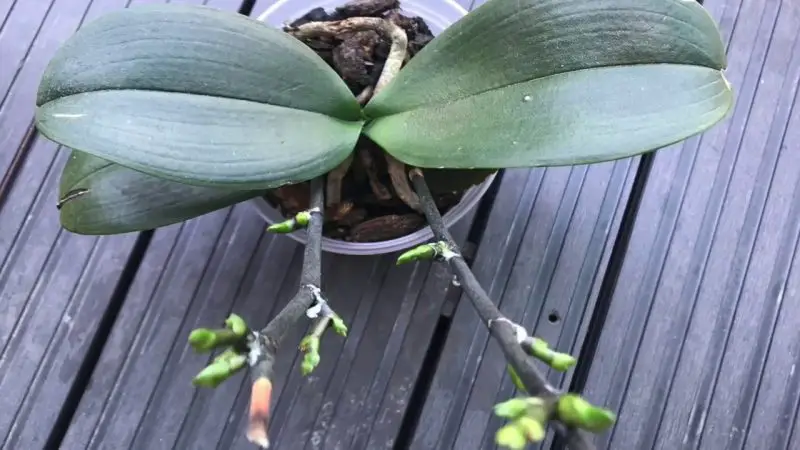
You might want to propagate your orchid but want to know how to get a keiki on my orchid.
You might be wondering what is a keiki. Well, it’s a Hawaiian word for a little one and it refers to a baby plant growing on an orchid stem.
Orchids have a reputation for being hard to grow. But really they are not. If you treat them like regular houseplants they will probably die.
They are put in the wrong grow medium and are overwatered. If you couldn’t breathe you would die too. It’s grower error that kills them.
But once you know how to grow them it’s easy. It is also easy to propagate them from keikis that grow on the plant.
But it does take time. It is not that hard. The hard part is waiting for your keiki to grow big enough to cut off the mother plant.
Still, orchids are expensive to buy and if you can propagate them they are free. All it takes is time and a bit of keiki paste to do it.
What Kind of orchid do you have?
Orchids have 2 main growth styles. They break down into monopodial species or sympodial species.
Monopodial orchids are defined as a single continuous growth axis that extends at its apex and produces successive lateral shoots.
So these orchids have one tall vertical stem. Some common monopodial orchids are Phalaenopsis and Vanda orchids.
The next type of orchid is the sympodial orchid.
Sympodial means “with conjoined feet”, and in biology is often used to refer to the outward morphology or mode of growth of organisms. In botany Plants with sympodial growth have a specialized lateral growth pattern in which the apical meristem is terminated. http://dictionary.sensagent.com/Sympodial/en-en/
So in simple English, they grow more like a bush. These orchids grow from a rhizome and they make pseudobulbs that can store water.
Dendrobium and cattleya are popular orchids in this class. The easiest way to propagate these orchids is by division.
Unfortunately, monopodial orchids like phalaenopsis and vanda can not be propagated by division. So keikis and stem cuttings are used.
If you have a large orchid you can cut the stem into sections with some attached aerial roots and chances are they will take.
HOW TO MULTIPLY YOUR ORCHIDS VIA CUTTINGS
Here is a video that shows you how to do this. He is using a large vanda in the video.
This is probably the easiest and fastest way to propagate a monopodial orchid. This method should work for phalaenopsis orchids too.
Most of us probably don’t have an orchid that big or if we do we may not want to chop it up.
Can You Propagate Orchids From Aerial Roots?
When I found this online I was pretty excited to share this technique. But as it turns out no one has ever done it.
So that was a bummer that people write things that aren’t true but it’s really not that surprising.
However, I was able to root a small broken dendrobium branch in coco coir. It did not have an aerial root on it either.
I may have to try this once I have some larger aerial roots to play with. Most of my orchids are still young.
They only reference how to grow new orchids from aerial roots and suggested putting them in water. Surely they would rot.
But I have an idea of how I might be able to propagate orchids using aerial roots. If it works there will be an update on it for sure.
So if you want to propagate your orchid you will probably need to do it with keikes.
How To Get A Keiki On My Orchid
Sometimes keikis develop naturally on orchids. But normally you will need to use keiki past to initiate growth.
A keiki is an exact clone of the mother plant and so it will grow and flower identically to its parent.
It is not a difficult process but don’t expect immediate results. It can take 4-8 weeks to see growth.
There’s an old saying “nothing good happens fast” and this is especially true with orchids.
The trickiest part of the procedure is finding a node on the branch that is not a flower bud.
I read that it is best to do this just before or during flower because that is when buds are most active.
Some branches start to die back after flowering and your keiki may not take.
Your bud will be covered with a sheath and you need to carefully peel it back to below the bud.
You will apply the past to the base of the bud. Don’t cover the whole bud with it. And now we wait for growth.
Once the keiki has aerial roots and about 3 leaves you can separate it from the mother plant and pot it up.
Here is a good video that will show you how to clone orchids with keikis.
How To Clone Orchids With Keiki Paste
How To Grow Baby Orchid Plants (Keikis)
Another good video on making and replanting keikis.
Here is an orchid growing keikis. Pretty cool that this one has 4 keikis.

Here is some more info on growing keikis. https://empressofdirt.net/clone-orchids/
Read more: Orchid Terrarium DIY
Read more: Are Orchids Hard To Take Care Of? Easy Growth Formula
This post contains affiliate links.



